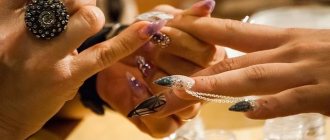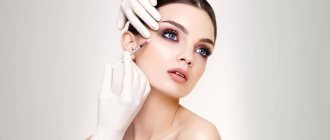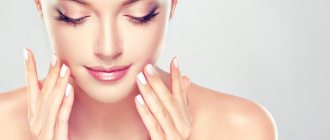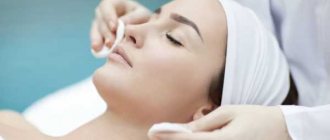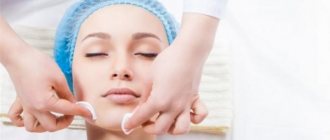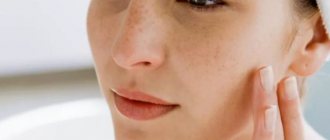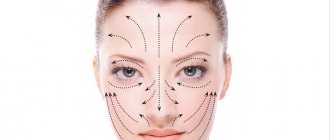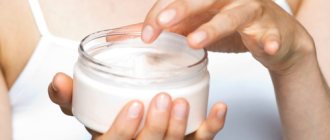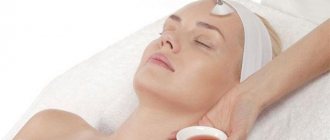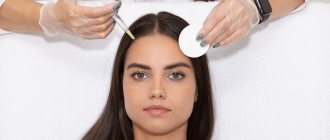The article was prepared by a specialist for informational purposes only. We urge you not to self-medicate. When the first symptoms appear, consult a doctor.
In just one day, our body secretes about 500 ml of water through the skin mixed with salt, urea, sebum, carbon dioxide and lactic acid. And this is only from the inside, and from the outside we are exposed to city dust and dirt, which is mixed with cosmetics. The face has many small pores located close to each other, in addition, it is an open part of the body - therefore, the skin of the face is constantly chapped, exposed to high and low temperatures, and irradiated by ultraviolet radiation. That is why, to preserve beauty, it is very important to provide your face with complete care and cleansing.
Cellular regeneration processes are constantly occurring in our skin, which are accompanied by the death of the outdated upper layer of the epithelium. High-quality facial cleansing involves not only removing impurities, but also exfoliating dead particles that slow down renewal and prevent us from seeing our attractive reflection in the mirror: fresh blush, healthy complexion, elastic and smooth skin. Skin of any type and any age needs regular cleansing, but for this it is not at all necessary to spend a lot of money on cosmetics.
Today we will tell you all about effective facial cleansing at home using natural and affordable ingredients. You will learn how to get rid of blackheads on your nose and prevent their appearance, which skin care products are suitable for your skin, and which ones are not recommended to use. The best recipes for cleansing face masks, homemade scrubs and peelings are waiting for you on this page - try it and see for yourself!
Cleansing normal facial skin
Let's start our conversation with the rarest skin type - normal. Alas, in modern realities, absolutely healthy skin with a smoothly functioning self-regulation mechanism is rare, mainly in children and very young girls.
This is interesting: Only about 8% of women aged 30-45 can boast of normal facial skin. Moreover, 75% of them practically do not use decorative cosmetics (they began to tint their eyelashes and lips after 20 years), wash themselves with baby soap, and limit their daily skin care to a light day cream.
You have normal facial skin if:
- After washing your face with soap or plain water, you never feel tightness;
- No greasy shine appears on the forehead, nose and chin 2-3 hours after washing; after waking up, your face does not look greasy;
- The skin never peels off or becomes stained by frost or heat;
- The pores are not enlarged, there are no pustular rashes;
- The face gratefully accepts any creams; they are quickly absorbed and do not cause irritation.
What people with normal skin should not do:
- Indulge in skincare products
. If you have normal skin, the main task is to maintain its status for as long as possible, that is, adhere to the principle of non-intervention. Most women believe that expensive, high-quality creams and masks can only bring benefits, because there can never be too much of a good thing. This is an erroneous opinion - with the help of strong cosmetics, especially those chosen incorrectly, you can disrupt the natural balance of the skin and ruin it forever;
- Neglecting facial cleansing
. Normal skin gives its owner a minimum of trouble and does not “revenge” sleep without makeup remover with redness and pimples. But this is for the time being. If you often go to bed unwashed and do not carry out cleansing procedures at least once every 2 weeks, very soon the healthy complexion will be replaced by grayness, peeling and black spots will appear on the nose.
Care for normal skin
It is very simple to provide normal skin with high-quality care, and it does not require large financial investments. The best means for cleansing the face in this case is regular baby soap (you can use cosmetic cream soap), or foam or gel wash. Particular attention should be paid to water quality. What makes it tough is the increased content of magnesium and calcium salts, which, when combined with soap and sebum, form insoluble compounds that are practically not washed off with water and leave a dense, harmful film on the face. Constantly washing your face with hard water can ruin normal skin.
This is important : Test the quality of the tap water in your home to determine if it is suitable for washing your face. To do this, pour water into a glass glass, put a teaspoon in there and leave for two weeks. If after this time a white circle forms on the inner surface of the glass along the edge of the water, and the spoon becomes rough, then the water is too hard.
There are two ways to solve the problem of hard water at home: boiling or freezing. Melt water is much preferable to boiled water, and it’s easier to prepare it - take the container out of the freezer in the evening, and the next morning soft, cool water is ready. You need to wash your face not only in the morning, but also in the evening, regardless of whether you use decorative cosmetics. During the day, a lot of dust and carbon monoxide accumulate on the surface of the skin, especially if you live in a big city and are often outdoors.
After washing your face in the morning, it is enough to moisturize your normal skin with a light day cream with a UV filter. In the evening before going to bed, you can apply a night nourishing cream, but for girls under 30 years old this is not at all necessary. You should start using special creams for the area around the eyes after 35 years. Owners of normal skin are recommended to use cleansing face masks no more than twice a month, the same applies to scrubs for deep cleansing of the skin and steam baths. Light peels can be used every week, but only if necessary (blackheads on the nose). The only product that can complement the daily care of normal skin without fear of disturbing its natural balance is an alcohol-free tonic based on natural extracts.
Which facial cleansing is best?
The choice of facial cleansing largely depends on the type of skin, its preliminary condition before the procedure, as well as the desired result.
For problem skin, mechanical facial cleansing by a cosmetologist is considered the most effective. It allows you to remove dirt and purulent formations in problem areas as much as possible. But this technique also has a small disadvantage - subsequent inflammation at the site of squeezed out acne and a burning sensation during the procedure. To speed up the recovery period, cosmetologists recommend:
- Avoid using cosmetics and makeup in the first days after the procedure.
- During the first week, refrain from going to the bathhouse and sauna.
- Protect your facial skin daily with sun creams.
For skin prone to excessive sensitivity and dehydration, ultrasonic cleansing is recommended. This method will not only cleanse the deep layers of the epidermis, but also restore metabolic processes without drying out the skin.
It is very difficult to single out one peeling option, since the choice is purely individual. Before starting cleansing therapy sessions, it is best to consult a cosmetologist. Only a qualified professional can advise you which facial cleansing is best done in a salon.
You should also remember that you should not get carried away with visiting a cosmetologist. Professional cleansing is useful, but everything should be in moderation. And don't neglect home care. Only an integrated approach will get rid of imperfections and make your skin glow.
Cleansing oily and combination skin
How to determine if you have oily skin type? It’s very simple: wash your face thoroughly with water at room temperature and baby soap (with soap, special cleansers are not suitable), pat dry with a clean towel and wait three hours, while doing your usual activities and being in a cool room. After the allotted time, place a thin piece of paper on your nose - if an oily trace remains on it, it means you have oily skin. However, do not rush to get upset: those with oily skin develop wrinkles on their faces on average 5-8 years later than women with dry skin. And with proper care and proper cleansing of the face, such skin can look quite decent.
This is interesting: About 30% of girls aged 16-20 have oily skin, and only about 10% of adult women. Meanwhile, the most common skin type is combination, when the T-zone is oily and the cheeks are dry. Approximately 70% of women aged 30-45 have this type of skin.
Oily facial skin is caused by increased activity of the sebaceous glands. This is either a hereditary trait or an acquired defect caused by hormones. It is not for nothing that “peak fat content” occurs during puberty and pregnancy (and sometimes menopause). If problems with oily skin become catastrophic, it is necessary to undergo examination by a dermatologist and endocrinologist, since it is impossible to cleanse oily facial skin at home with cosmetic products alone.
What people with oily skin should not do:
- Wash with hot water
. In an attempt to achieve cleanliness and eliminate the treacherous shine, many girls thoroughly wash their face with soap and hot water, because high temperature helps to dissolve sebum. There is no need to do this under any circumstances - the sebaceous glands will immediately begin to intensively compensate for the dryness, and within an hour after such a procedure the skin will shine again;
- Wipe your face with alcohol lotions
. It would seem that such cleansing, tightening and disinfectants were invented specifically for oily, acne-prone skin. However, if you apply them not precisely to the source of inflammation, but to the entire surface of the face, and even do this daily, you can achieve the exact opposite effect, for the same reason as described in point 1. The more we dry out the skin, the more active they work sebaceous glands.
Care for oily skin
You shouldn’t wash your face too often; it’s enough to do it three times a day: in the morning after waking up, in the evening after coming home from work/school (full make-up removal) and at night before bed. You need to wash off your makeup in the bathroom; makeup remover milk is inappropriate here. Any soap is absolutely not suitable for washing oily facial skin - as we mentioned above, sebum reacts with hardness salts contained in water, and an irritating film forms on the face. The best choice is gels and foams for washing with a pH level of no higher than 4.5, containing special components for regulating the activity of the sebaceous glands, narrowing pores and gently disinfecting acne (for example, chamomile, calendula or tea tree extract).
Light daytime moisturizing cream-gels that are quickly absorbed are ideal as care products for oily skin. Just because your skin is oily doesn't mean it doesn't need regular moisturizing. At night, you should not apply heavy nourishing creams to your face, especially oil-based ones. Until the age of 30, those with oily skin should not use night cream at all - it is better to make a nourishing mask from natural products before going to bed. Alcohol-free toners will only benefit oily skin, especially those containing lemon or cucumber juice.
Cleansing oily facial skin at home should be carried out according to the following schedule:
- 2 times a month – full-scale procedure with a steam bath;
- Once a week – scrub, peeling or mask for deep cleansing of the skin;
- 2-3 times a week – light peelings and scrubs.
This is interesting: How does a scrub differ from peeling? The scrub contains small polishing particles that provide mechanical removal of the keratinized top layer of skin and cleansing impurities from the pores. Peeling contains components that dissolve sebum (for example, fruit acids), that is, it provides chemical cleansing of the face.
If you have oily skin prone to inflammation and acne, it is preferable to use homemade cleansing masks and peels rather than scrubs. Peeling removes dirt and excess sebum more gently, and a properly selected mask soothes the sebaceous glands. As for scrubs, especially those containing large and sharp polishing particles (ground nut shells, apricot kernels), they injure inflamed skin. Subsequently, microtraumas easily become infected, and since sebum is a free environment for the proliferation of pyogenic bacteria, new rashes appear on the face.
Is it possible to squeeze out pimples and blackheads on the face? Definitely yes, but only if they are already ripe and come out easily. In addition, cleansing oily facial skin mechanically is possible only after careful preparation (steaming and disinfection). If you squeeze a pimple with dirty hands, the wound will almost certainly become inflamed. And the longer such wounds take to heal, and the more often they are reinfected and picked apart, the more obvious the scars remain in their place. Getting rid of acne scars is very difficult.
Advantages and disadvantages of ultrasonic cleaning
Advantages
- has a gentle effect on the skin and does not leave redness;
- practically painless (only a slight tingling sensation may be felt);
- in addition to the cleansing effect, it has a rejuvenating effect and helps get rid of shallow wrinkles;
- does not require special preliminary preparation;
- short-lived;
- safe – minimal risk of infection.
Flaws
- does not relieve inflamed acne and deep comedones;
- has many contraindications;
- short-term effect - cleaning must be done every 2-3 weeks.
Using ultrasonic devices it is impossible to deeply clean the sebaceous ducts. In the presence of comedones and multiple inflammatory rashes on the skin, the hardware method is not effective enough.
Cleansing dry and sensitive facial skin
You can tell if you have dry skin by the following signs:
- Washing with plain water causes a feeling of tightness, while washing with soap causes itching and burning;
- The skin often peels, especially around the nose and cheeks;
- Ice water and cold wind cause red spots to appear on the face;
- The forehead, nose and chin sweat in the heat, but do not shine with a greasy sheen;
- The creams are instantly absorbed (“like dry soil”), and after a few hours discomfort reappears.
This is interesting: About 25% of women aged 30-45 years and more than half of all representatives of the fair sex who have crossed the forty-five year mark have dry facial skin. Dryness is explained by a gradual decrease in the activity of the sebaceous glands, the fading of the regeneration function of the skin and shifts in hormonal balance.
Despite the lack of moisture and increased sensitivity, thin and dry skin also needs regular cleansing. After all, if you do not help skin cells get rid of keratinized particles, the renewal of the epithelium will significantly slow down. However, cleansing dry facial skin requires a very delicate approach, and it must be combined with the use of moisturizing and nourishing creams and masks. You will find the best recipes for gentle cleansing face masks, enriched with natural beneficial ingredients, further in our article.
What people with dry skin should not do:
- Leaving cosmetics on your face that are not intended for this purpose
. We are talking about numerous foams, gels and creams for washing. Since they moisturize well and have a pleasant consistency, some girls deliberately do not wash them off completely, hoping to avoid tightness and maintain a feeling of comfort. This should not be done - dust and dirt will quickly stick to the skin treated in this way, the pores will become clogged, and irritation will appear. Cleansers should be rinsed from the face 8-10 times with warm water;
- Rub your face with ice cubes
. This is a very popular and effective toning procedure, however, you should not resort to it if you have dry and sensitive skin. The burning cold will cause red spots to appear on your face; in addition, if the subcutaneous capillaries are close, they may burst. Contrast and ice washes are also contraindicated for girls with dry skin;
- Apply creams using smearing movements
. To ensure that the product is well absorbed and does not cause irritation, it must be lightly “pounded” into the skin with your fingertips. This advice is relevant for those with any skin type, but dry and sensitive skin – especially since it is prone to the early appearance of wrinkles. The cream must be distributed following the correct trajectories and avoiding stretching the skin.
Care for dry and sensitive skin
There is currently a wide selection of cleansing emulsions on the market that can be used instead of traditional morning routines. The emulsion is a neutral mixture of a fat base and water (fat content 25-50%). When applied to the face, this product simultaneously cleanses thin, dry skin and impregnates it with oils, like tissue paper. However, make sure that you choose the right cleansing emulsion and do not confuse it with regular makeup remover milk.
If you prefer to wash your face with water and delicate foam, take care of the quality of the water. Hard water has the most detrimental effect on dry facial skin, so it is better to prepare melted water or purchase micellar water. Frequent washing is harmful to dry skin as it causes flaking. It is enough to wash your face twice a day, and after each procedure apply a cream to your face: in the morning, a daytime moisturizer with a good UV filter, in the evening, a nourishing and rejuvenating one (after 30 years). Dry and thin skin around the eyes needs a separate care product from about 25 years of age.
It is recommended to cleanse dry facial skin at home 1-2 times a month: a steam bath, then a soft scrub and finally a soothing mask. If you choose between a scrub and peeling, then a scrub is preferable for dry skin, since only with its help can you eliminate visible peeling that prevents you from applying makeup evenly. Facial peels, especially aggressive ones (for example, with salicylic acid) irritate sensitive skin and aggravate dryness. The same applies to alcohol lotions.
What can you achieve by cleansing your facial skin?
For any skin condition, after cleansing the face, the skin becomes more well-groomed and smooth. It is easier to apply makeup on it. The skin responds better to nourishing and healing creams - their action becomes more effective. Pore size decreases. This significantly reduces the likelihood of skin inflammation. Like peelings, facial cleansing for acne helps remove dead cells and stimulates renewal and rejuvenation of facial skin. It is not possible to cope with acne solely by cleansing your face. But this procedure is effectively used at one of the stages of skin treatment.
Homemade skin cleansing treatments
If you want to have a healthy complexion and smooth, elastic skin, make it a rule to have a “cleansing day” at least once a month. Do not plan any activities outside the home for the evening of this day, since you cannot go outside after a home skin cleansing procedure: firstly, you can catch a cold, and secondly, dirt will immediately get into the open pores.
Complete skin cleansing at home includes several steps:
- Steaming the face over a bath;
- Removal of comedones (if any);
- Exfoliation of the keratinized top layer of skin;
- Face mask (cleansing, moisturizing, nourishing, tightening pores - the choice depends on your facial skin type).
To prepare a steam bath, you will need a medicinal herb from a pharmacy:
- For dry skin
– oregano, thyme, linden;
- For oily skin
– coltsfoot, nettle, mint;
- For acne-prone skin
– calendula, St. John’s wort, yarrow;
- For normal skin
– chamomile, lavender, string.
Pour boiling water over one tablespoon of the selected herb, cover the container with a plate and wait 5 minutes. When the herb is brewed and the boiling water has cooled a little, sit over the bath, tilt your face and cover yourself with a terry towel. By the way, if you don’t want to bother with herbs, you can use essential oils instead - just a few drops with your favorite scent of rose, bergamot, orange, patchouli, ylang-ylang or tea tree.
It is best to steam the skin for at least 15 minutes, then the sebum will completely dissolve. After the allotted time, do not rush to remove your head from under the towel - the temperature difference will immediately close the pores. Instead, roll up a hot towel, cover your face, and lie there until it cools down. Then blot the steamed skin and sit in front of a magnifying tabletop mirror.
If you want to get rid of blackheads on your nose, now is the time to do it. Wrap your fingers in a sterile bandage or napkin moistened with hydrogen peroxide, and with light pressure in counter movements, clean the pores around the nose, forehead and chin from comedones and excess sebum.
This is important: Do not squeeze out pimples and blackheads with long nails. Firstly, this does not work well, since the area of the tip of the nail is very small, and successful extrusion is ensured by crushing the entire thickness of the skin at the desired angle, and not by applying pressure to one point. Secondly, it is fraught with injury.
It is best to perform mechanical cleansing of the face using very short nails or just fingertips. There are special metal devices in the form of loops, but reviews about them are very controversial - some like to remove pimples and comedones with their help, others do not. Do home facial cleansing in the way that is most convenient for you, the main thing is to maintain sterility and do not try to squeeze out an intractable pimple at any cost. This will only damage the skin, leaving an unsightly red spot, and the pimple will become more inflamed and will take longer to mature.
Comparison table of methods
For a more clear comparison of the features, advantages and disadvantages of mechanical and ultrasonic facial cleansing, we recommend that you familiarize yourself with the table.
| Comparison criterion | Mechanical cleaning | Ultrasonic cleaning |
| Operating principle | Cleansing the skin by a cosmetologist using tools | Skin cleansing using an ultrasonic device |
| Feelings during the procedure | Painful | No discomfort |
| The effectiveness of cleansing sebaceous ducts | Removes deep comedones, allows you to completely clean the sebaceous ducts | Gets rid of surface contaminants, but is not able to clean the sebaceous ducts to the base |
| Indications | Inflammatory processes of the facial skin, blackheads, comedones | Blackheads, acne, uneven complexion, hyperpigmentation, sagging skin |
| Contraindications | Skin diseases in the acute stage, herpes, menstruation period | Skin diseases, cancer, dilated blood vessels, hypertension, ternary neuralgia |
| Recommended age | Adolescence, up to 35 years | Suitable for mature skin with the first signs of aging |
| Duration of the procedure | About 60 minutes | 30-40 minutes |
| Frequency | Once every 1.5-2 months | Monthly or every 2 weeks |
| Consequences of the procedure | Redness and swelling remain, which disappear only after 2-3 days | Leaves no trace |
| Safety | If antiseptic rules are not followed, there may be a risk of infection. | Quite safe, does not cause complications (in the absence of contraindications) |
| Price (varies depending on the region and level of the beauty salon) | 1000-2500 rubles | 1300-5000 rubles |
Products for cleansing skin from blackheads
Comedones, or blackheads, are small plugs of sebum, the top of which is contaminated with street dust and cosmetic residues, which is why they stand out so unattractively against the background of the face. It is necessary to remove comedones, and not only because they spoil the appearance. Old sebaceous plugs tend to increase in volume over time and stretch the pores. And when you finally remove the large comedone, a real “lunar crater” will remain in its place. To prevent this, cleanse your face regularly.
This is important: It is useless to apply cleansing masks and anti-blackhead products to unsteamed skin. All kinds of patches and films that have to be torn off from the face remove the top layer of the epidermis, and the sebaceous plugs continue to sit in their places. Assurances that comedones will “stick” to the patch and remain on its inner surface are pure myth.
Best home remedies for blackheads on nose:
- Protein mask
– beat the white of one egg into a stiff foam, apply it to the area covered with comedones, and place a paper napkin folded 2-3 times on top. When it dries a little, apply a second layer of protein foam and wait until it dries completely. The napkin should become hard, then you can easily and carefully remove it from your face. Protein perfectly pulls sebum out of steamed pores, since it is very sticky and shrinks greatly when it dries;
- Black mask for blackheads
– crush 1 tablet of activated carbon, add half a teaspoon of gelatin to it and steam this mixture with 1 tablespoon of hot milk. After a few minutes, when the gelatin has dispersed and the mass has cooled a little, apply it to the steamed nose and the area around it. After 20-30 minutes, the mask will dry completely and look like a shiny film, then you can remove it. The principle of operation of this remedy for blackheads is the same - drawing out and adsorption of impurities during the drying process.
How to get rid of blackheads using lightening?
If your nose is covered with small black dots that just don’t want to be squeezed out, don’t despair.
You can get rid of them by bleaching:
- Salt, soda and baby soap
– Add 1 teaspoon each of salt and baking soda to the soap solution. Place the resulting mixture on a cotton pad, toothbrush or a special facial cleansing brush and massage the skin of your nose for 3-5 minutes, then rinse thoroughly. Repeat these procedures 2-3 times a week, and within a month the small comedones will completely lose their black “lids” and will no longer be conspicuous;
- Lemon juice and hydrogen peroxide
– mix one teaspoon of the above ingredients with a tablespoon of water. Soak a cotton pad generously and wipe the area covered with blackheads every evening for two weeks. During this time, the comedones will discolor, but keep in mind that this remedy for blackheads is not suitable for girls with very dry and sensitive skin.
Features of mechanical cleaning
Mechanical facial cleansing is one of the methods of facial cleansing, in which a cosmetologist removes the stratum corneum of the epidermis and dirt manually - with fingers and special devices:
- Uno spoon;
- loop;
- spatula;
- Vidal needle;
- spoon "mesh".
The procedure begins with cleansing the face of makeup, then light peeling with fruit acids is used. To open the pores deeper, use a steam bath, a warming mask or a special thermogel.
After the preparatory procedures, the cosmetologist uses tools to remove black and white dots and comedones (nodules that form due to blockage of the sebaceous gland ducts with dead epidermal cells). At the end of the procedure, the treatment sites are treated with an anti-inflammatory agent. The duration of cleansing is 40-60 minutes.
If the skin is seriously affected by inflammation, manual techniques are combined with vacuum cleaning - a glass tube with reduced pressure inside is used. It easily sucks out sebaceous plugs from pores even in the most difficult cases.
All manipulations are carried out with disinfected instruments under sterile conditions. The final result and sensations during the procedure largely depend on the professionalism of the cosmetologist.
Manual technique is effective in adolescence - deep cleansing of pores and sebaceous ducts helps fight acne and prevents subsequent inflammatory processes in the epidermis.
The best cleansing face masks
We bring to your attention recipes for cleansing masks that are suitable for any skin type and at the same time saturate your face with useful substances:
- Kefir cleansing mask
– heat a quarter cup of 3.2% kefir in a water bath, soak a piece of clean gauze in it and apply it to your face for 10-15 minutes. The acids contained in kefir gently dissolve sebum and restore a healthy pH level if the skin is too oily and its environment is alkaline;
- Rice cleansing mask
- a popular Japanese recipe for cleansing facial skin at home. Thoroughly rinse half a glass of round rice with running water, then pour three times the volume of warm boiled water over it and leave it overnight. In the morning, drain the excess liquid, mash the rice to a paste and apply to clean facial skin for 15-20 minutes;
- Cucumber Protein Cleansing Mask
– peel one small fresh cucumber and grate it on a fine grater. Beat the white of one egg into a stiff foam and mix with grated cucumber. Apply to face and leave until dry, then rinse with cool water. This mask is especially suitable for those with enlarged pores;
- Yeast Cleansing Mask
– recommended for dry and mature skin, perfectly saturates with vitamins. Mash a small cube of fresh baker's yeast in warm milk and apply the resulting mass to the skin of the face and décolleté. Leave for 15-20 minutes and rinse with water at room temperature;
- Potato cleansing mask
– optimal for oily skin, it removes excess sebum well and reduces its secretion. Grate raw potatoes on a fine grater and apply the resulting mixture to your face, paying special attention to the T-zone. Leave on for 10 minutes and rinse with cool water;
- Cleansing mask made from cosmetic clay
- a universal option, since you can choose clay for your skin type: red - for dry, pink - for mixed and normal, blue, green and white - for oily and problem skin. The clay is diluted with warm water to a comfortable consistency and applied to the entire face, avoiding the area around the eyes, for 10-15 minutes, and then rinsed off thoroughly;
- Herbal cleansing mask
– has additional healing properties, depending on the choice of medicinal plant. Oily facial skin can be soothed and disinfected with calendula, yarrow, St. John's wort or sage. For those with dry skin, linden blossom, rosehip and thyme are perfect. Almost any herb is good for normal skin; opt for the classic options: chamomile, mint, lemon balm. A small amount of raw material needs to be crushed with a coffee grinder, added a little warm water until a homogeneous paste is obtained and applied to the face for 15-20 minutes, and before rinsing off, lightly massage the skin - you get a scrub effect.
How to cleanse your face at home?
The easiest and cheapest way is cosmetic clay, which can be bought at any pharmacy. For oily skin, choose green, white and blue clay. If you have dry skin, then you need to buy red clay. Black clay is suitable for any skin type. This product must be diluted with water (preferably mineral water). The consistency of your mask should resemble a thin porridge. Keep this mask for 15 minutes, then rinse with warm water and apply moisturizer. Remember that no powder or foundation can give you the same effect as regular facial cleansing.
Among common cosmetic procedures, one of the leading places is occupied by cleansing the skin of excess impurities and dead cells. Facial cleansing, the prices of which are kept within moderate limits, is performed for hygienic purposes, in addition, it stimulates metabolic processes, nutrition and blood supply in the upper layers of the skin. The procedure is recommended for both men and women, starting from the age of puberty.
Scrubs for deep skin cleansing
Try homemade scrub recipes based on natural ingredients - it's simple, healthy and economical:
- Semolina scrub
– the particles of semolina are quite small and not sharp, which allows you to use semolina as a base for all kinds of homemade scrubs. The easiest option is to mix semolina with heavy cream or sour cream;
- Oatmeal scrub
– in this case, the oatmeal will first have to be ground with a coffee grinder. Oatmeal-based scrubs are very gentle and ideal for sensitive facial skin. You can mix ground oatmeal with sour cream, whipped egg white or natural yogurt, but you need to start the procedure immediately, since the grain particles swell quickly;
- Coffee scrub
– natural ground coffee is also perfect as a base for homemade scrubs. Particularly good options: coffee + banana pulp and coffee + full-fat cottage cheese. These products are very easy to use and at the same time beneficial for facial skin of any type;
- Sugar scrub
– preferable for cleansing dry facial skin. Fine sugar is mixed with sour cream, cottage cheese, avocado or banana pulp. Such compositions must be used immediately after preparation, since sugar melts quickly;
- Honey-salt scrub
– is more suitable for those with oily facial skin, but if you use it on the body after a bath, then it is simply a fairy tale for any skin type. A facial scrub is prepared from a tablespoon of honey and half a teaspoon of finely ground salt, and for the body choose coarser table salt or better sea salt, approximately maintaining the above proportions;
- Egg shell scrub
– best copes with the problem of flaky facial skin. The shells of several eggs must be ground very thoroughly with a coffee grinder, literally “into dust.” Then we will get small, dense particles that perfectly remove the stratum corneum of the skin without injuring it. You can mix ground shells with any of the above bases, but best of all – with full-fat cottage cheese and cream;
- Almond-orange scrub
– the most fragrant and pleasant to use homemade scrub recipe. Grind a handful of almonds with a coffee grinder to a crumb size of 1-2 mm in diameter, then add a little freshly squeezed orange juice (or preferably lemon juice if your skin is very oily) and easily massage your face with this mixture for a few minutes.
It is recommended to use natural scrubs for deep cleansing of the skin, regardless of its type, more often than 1-2 times a week. Take care of yourself and be beautiful!
Author of the article:
Kuzmina Vera Valerievna |
Endocrinologist, nutritionist Education: Diploma of the Russian State Medical University named after. N.I. Pirogov, specialty “General Medicine” (2004). Residency at the Moscow State Medical and Dental University, diploma in Endocrinology (2006). Our authors
Peeling
All peeling products can be divided into 3 main groups according to their mechanism of action:
- Mechanical peeling (manual peeling, hardware peeling, micro-polishing);
- Physical peeling (ultrasonic peeling, laser peeling);
- Chemical peeling (based on the use of different substances).
In addition, peeling methods should be distinguished by the degree of “aggression” (depth of penetration into the skin layers):
- exfoliation, i.e. exfoliation of the stratum corneum;
- epidermolysis, i.e. superficial peeling procedure;
- medium peeling
- deep peeling
Superficial peeling
Superficial peeling affects only the upper layer of the epidermis - from horny to granular. It is recommended to prevent skin aging. Superficial peeling evens out the surface of the skin, improves the color and texture of the skin: pores narrow, wrinkles become less noticeable. In this case, only the horny cells of the epidermis are exfoliated. A peeling course consists of 5–7 procedures, the interval between which is a week. The very next day you can use cosmetics. For the procedure, fruit (alpha hydroxy) acids of varying concentrations are used, which depends on the type and condition of the skin (determined by the doctor).
Superficial peeling is the most gentle compared to medium and deep peeling. Its essence is damage, creating a burn surface on the skin. An acid of a certain concentration and strictly in time is applied to cleansed skin with a brush. The deeper the peel, the stronger the acid used and the more difficult the procedure.
Soft: the stratum corneum is destroyed to the granular layer (stratum granulosum). These include: Jessner solution, CO2, dry ice, fruit acids 20-70%, trichloroacetic acid 15%.
Superficial peeling is performed without anesthesia and is accompanied by severe redness of the skin, itching and peeling. Feeling as if someone walked over the face with a pumice stone. In the coming days, the skin begins to peel off and dry crusts appear.
At this time, the skin is treated with special products and wound-healing medications. The success of the procedure largely depends on skin care after the procedure. It is very important not to peel off the crusts and husks until they come off on their own. For a certain period of time, you should not appear in the sun, much less sunbathe, otherwise age spots will appear on your face, which are very difficult to eliminate. The remission period is 2-3 weeks.
Facial cleansing with fruit and other acids is essentially an exfoliation. These procedures are used after mechanical or hardware facial cleansing to smooth out the skin texture and remove dead cells.
If there is acne on the skin (not in the inflammatory phase!), then you can use superficial acid peeling to remove plugs from the pores. Chemical peeling with fruit acids refreshes the skin and cleanses surface impurities, but does not reach deep-lying inflammations.
In these cases, chemical peeling can only be the final stage after mechanical and other cleaning methods. The peeling procedure can be called “aggression for good.” The ability to regenerate is the most important property of the skin, without which it could not act as a barrier between the body and the external environment. The slightest breach in it can become fatal, so the reaction to damage occurs immediately. A signal for restoration work is any traumatic impact: a scratch, abrasion, burn, exfoliation of horny scales, etc.
Fruit peeling is a gentle facial cleansing that gently cleanses the skin of dead cells and toxins. Thanks to a gentle technique, this type of peeling can be used without any age restrictions, which makes it possible to prevent the formation of wrinkles at the very initial stages, improve the functioning of the sebaceous glands, the process of skin regeneration, and also stimulate the synthesis of collagen fibers, which are responsible for the elasticity and smoothness of the skin. Cosmetology specialists recommend fruit peeling for facial skin with signs of photoaging, since this procedure has not only a smoothing, but also a brightening effect. In order for the effectiveness of such peeling to be maximum, it is necessary to follow several simple rules.
The most important thing, of course, is to follow the advice of a cosmetologist who conducts a series of peeling sessions, the number of which can vary from 4 to 10 depending on the method of implementation, the concentration of the active substance and the condition of the skin. And also remember that for 30-40 days after and directly during the procedure, sunbathing is strictly contraindicated, and even better, constantly use sunscreen with a high degree of protection.
It should also be understood that such peeling does not give an immediate effect, and its positive effects appear gradually. That is, every day your facial skin will become younger and healthier. The process of gently cleansing the skin of the face itself is based on the action of AHA acids, which, due to their natural origin, are known in the same way as fruit acids. Although today these substances can also be obtained artificially, which does not make them less effective. The most commonly used are citric, glycolic, lactic, tartaric and malic acids.
Each of them has its own characteristics, but many cosmetologists believe that the best peeling is glycolic. This is explained by the fact that the molecular sizes of this acid are much smaller than others, which guarantees a deeper penetrating effect. Most specialists use a mixture of several acids.
Also, AHA acids, for a more pronounced and lasting effect, are combined with other substances, for example, vitamins A, E, salicylic acid (for deeper cleansing), etc.
The fruit peeling procedure is a seemingly simple process, but it requires specific knowledge, skills and experience. Therefore, it is better to trust its implementation to experienced professionals who have positive recommendations and characteristics.
Complications arising during the rehabilitation period
Post-inflammatory pigmentation
Uneven pigmentation can occur in response to any deep damage to the skin. Exposure to the sun without sunscreen increases pigmentation.
Exacerbation of acne
Patients with seborrhea (oily skin) or acne may develop rashes 2-4 weeks after the procedure.
Wide pores
Chemical peels can stimulate pore enlargement. This most often occurs in people with thick skin. Enlarged pores appear 3-4 weeks after the procedure, and disappear at 6-10, since by this time new collagen fibers are formed.
Persistent increase in facial skin sensitivity
When performing deep peels on people with thin, dry, sagging skin, sensitivity may increase. This condition can last from several weeks to several months and is accompanied by redness of the skin.
Late complications
- Hypertrophic reactions (uneven thickening of the skin)
- The upper lip, cheeks, and lower eyelids are most susceptible to these complications; this is especially common with deep peels.
- The development of hypopigmentation (areas of skin lacking pigment) depends on the depth of peeling. Most often occurs after phenol and deep TCA peels.
- Patients with thin, sensitive skin are at risk of developing this complication.
It must be said that it is not enough to have the procedure done in a clinic; it is also important to properly care for your facial skin during its recovery period.
Post-peeling care includes the use of cosmetics containing antioxidants and wound-healing components (vitamin A, E, F, panthenol), moisturizers (hyaluronic acid), products that soften and restore the structure of the barrier (lipid) membrane (shea butter, vegetable and mineral oils ). The use of photoprotective products is mandatory. It is necessary to avoid exposure to the sun (solarium, beach tanning). For medium peels, you should initially refrain from visiting the bathhouse or sauna.
